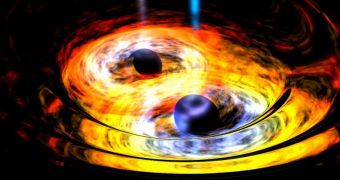A group of investigators from the NASA Jet Propulsion Laboratory (JPL), in Pasadena, California, announce the discovery of a pair of supermassive black holes at the core of the WISE J233237.05-505643.5 galaxy. The objects lie around 3.8 billion light-years from Earth.
This means that we see them as they looked when the solar system was just emerging from a tumultuous period in its history, called the Late Heavy Bombardment. This series of comet and asteroid impacts occurred between 4.1 and 3.8 billion years ago, and brought a lot of water on our planet.
The new supermassive black hole duo was detected using the NASA Wide-field Infrared Survey Explorer (WISE) telescope, which investigates the night sky in infrared wavelengths. This duo is one of only a handful of black hole pairs identified to date.
The main issue with finding such structures in space is that a black hole is difficult to detect all by itself, let alone in combination with another. The study is important because it identifies a new duo, but also because this structure is located much farther away from Earth than previously known ones.
In addition to WISE observations, scientists also used data from the Gemini South optical telescope, in Chile, and the Australian Telescope Compact Array (ATCA), near Narrabri, Australia. The three observatories were together able to identify some weird features in the supermassive black hole duo.
One of the most unusual features was a lumpy jet of radiations emanating from the center of the WISE J233237.05-505643.5 galaxy. Astrophysicists hypothesize that the lumpiness of the jet may be caused by one of the black holes, which causes the regular-shaped emission jets of the other to be distorted.
“We think the jet of one black hole is being wiggled by the other, like a dance with ribbons. If so, it is likely the two black holes are fairly close and gravitationally entwined,” says JPL scientist Chao-Wei Tsai. He is the lead author of a new paper detailing the duo.
The work was accepted for publication in the December 10 issue of the Astrophysical Journal. The team says that studies such as this may finally help experts figure out how supermassive black holes grow through merging with other black holes.
“At first we thought this galaxy's unusual properties seen by WISE might mean it was forming new stars at a furious rate. But on closer inspection, it looks more like the death spiral of merging giant black holes,” says JPL WISE project manager, Peter Eisenhardt, who was also a coauthor of the paper.
If these two objects are in the process of merging, then the duo at the core of the WISE J233237.05-505643.5 galaxy could represent a perfect target for future missions destined to discover gravitational waves, distortions of space and time believed to occur during such massive mergers.

 14 DAY TRIAL //
14 DAY TRIAL //